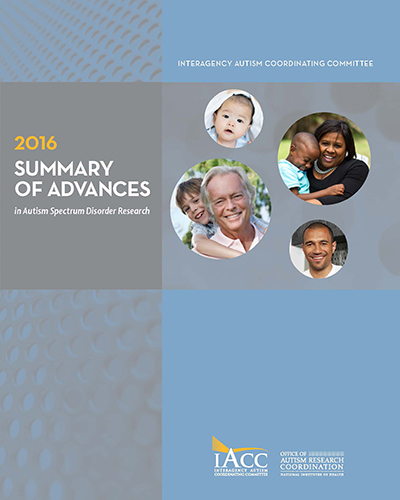Summary of Advances
In Autism Spectrum Disorder Research
2016
Premature mortality in autism spectrum disorder
Hirvikoski T, Mittendorfer-Rutz E, Boman M, Larsson H, Lichtenstein P, Bölte S. Br J Psychiatry. 2016 Mar;208(3):232-8. [PMID: 26541693]
Past research suggests that individuals with ASD have a higher risk of premature mortality, but the specific factors that impact this risk are unclear. Individuals with ASD often have co-occurring medical conditions, such as seizures and intellectual disabilities, which may be associated with increased risk of premature mortality. Further, previous studies have found that females with ASD have a higher risk of mortality than males with ASD. The goal of this study was to understand the causes of mortality in individuals with ASD and determine the impact of gender and intellectual ability on mortality rate.
To conduct this study, the researchers compared causes of mortality in both the general population and in the ASD population. They also compared mortality in high- and low-functioning ASD to assess the effect of intellectual disability. Their data sources were Swedish population-based registers (the National Patient Register and the Cause of Death Register), which included 2,672,185 individuals from the general population and 27,122 individuals with ASD.
The researchers found that the death rate in the ASD population was greater than in the general population. In the time period studied, 0.9% of people in the general population had died, compared to 2.6% of people in the ASD population. The average age of death for the ASD population was 53.87 years, compared to 70.20 years in the general population. When comparing low- and high-functioning individuals with ASD, the researchers found that the age of death was significantly different between the two (39.5 years of age for low-functioning ASD, compared to 58.39 years for high-functioning ASD).
Compared to the general population, the death rate for individuals with ASD was significantly elevated for all categories of cause of death except for infections. The largest differences between the two groups were deaths caused by diseases of the nervous system and suicide. Low-functioning individuals with ASD had higher mortality rates than did high-functioning individuals with ASD for all causes of death, except for suicide. This result was consistent with previous data that suggest that individuals with high-functioning ASD have a high rate of suicide. In low-functioning individuals with ASD the most common cause of death was epilepsy.
When comparing across gender, the researchers found that the rates of death were comparable between males and females with ASD for most causes of death; however, there were some differences. The risk of dying from diseases of nervous and circulatory systems was higher in males with ASD than in females with ASD. Endocrine diseases, congenital malformations, and suicide were more common in females with ASD. When comparing differences between gender across low- and high-functioning groups, the mortality rate for low-functioning females with ASD was particularly high.
Together, these results indicate that biological health and medical care access may make individuals with ASD more vulnerable to premature death. Education and awareness programs to help individuals with ASD identify and seek help for co-occurring medical conditions and suicide risk are warranted.
Effects of an employer-based intervention on employment outcomes for youth with significant support needs due to autism
Wehman P, Schall CM, McDonough J, Graham C, Brooke V, Riehle JE, Brooke A, Ham W, Lau S, Allen J, Avellone L. Autism. 2016 May 5. [Epub ahead of print] [PMID: 27154907]
High school graduates with ASD often have difficulty finding and keeping employment, which can have a significant impact on quality of life and independence. Additionally, individuals with ASD have higher rates of underemployment and unemployment than similar disability populations. The goal of this study was to develop and test an employment training intervention to help high school graduates with ASD succeed in post-graduate employment.
The training model used in this study was a modified version of Project SEARCH (Project SEARCH plus Autism Spectrum Disorder Supports; PS-ASD), an intensive job training program for young adults with developmental disabilities. To modify Project SEARCH to PS-ASD, the researchers embedded applied behavior analytic (ABA) techniques. These included teaching multistep tasks, demonstrating self-management for behavioral challenges, and increasing training for specific communication skills. The trainers also helped students with understanding statements that are common in the workplace, but may not be intuitive for individuals with ASD, such as “act professional” and “take the high road” by first defining and then demonstrating their meanings.
The researchers compared the ability to find and keep a job across high school students with ASD enrolled in PS-ASD and high school students with ASD enrolled in typical special education services. The study included 49 students with ASD at ages 18-21. The main outcome measure in this study was the Support Intensity Scale (SIS), an interview that measures the amount of support an individual needs across home living, community living, lifelong living, employment, health and safety, and social skills. The SIS interview was conducted at four times throughout the study (at the start of the program, at graduation, at 3 months, and at 12 months following graduation), from which researchers compiled a Support Needs Index (SNI) score for each student.
At 3 months after graduation, 90% of the students who participated in the PS-ASD program had acquired parttime jobs and 87% of those students kept their jobs for 12 months after graduation. In contrast, at 3 months after graduation, only 6% of the students who participated in the special education program acquired jobs and only 12% had found jobs at 12 months after graduation. In addition, students in the PS-ASD group acquired more independence than the students in the special education program, as evidenced by SNI scores as the study progressed.
The results of this study show promising evidence in support of an employment training intervention tailored to the unique needs of students with ASD. Improved employment outcomes and independence would provide a significant positive impact to young adults with ASD as they transition from high school.




